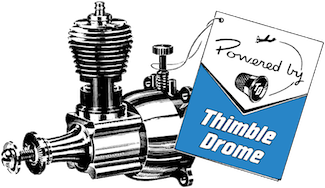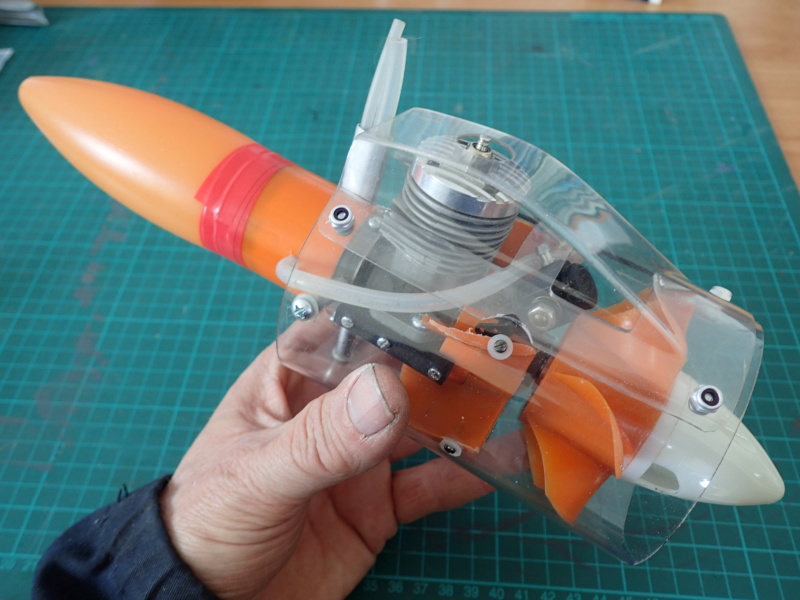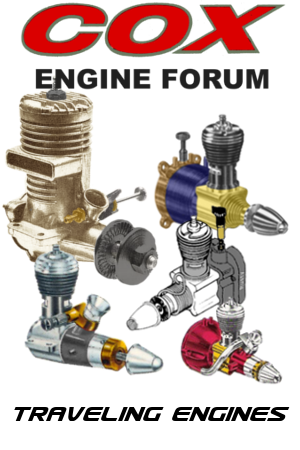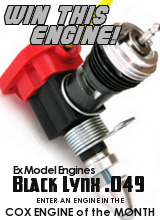Log in
Search
Latest topics
» Fox .35 Modifications by Onelife Today at 6:47 pm
» Happy Anzac Day!
by 706jim Today at 6:44 pm
» Project Cox .049 r/c & Citabrian Champion
by MauricioB Today at 4:08 pm
» Jim Walkers FireBee - This is going to be fun
by rsv1cox Today at 3:56 pm
» Revivng Some Childhood Classics
by rsv1cox Today at 7:17 am
» Introducing our Cox .049 TD Engines
by getback Today at 6:20 am
» Roddie's flat-bottomed boat..
by Levent Suberk Today at 12:23 am
» Cox powered jet-pump for model Sprint Boat
by roddie Yesterday at 10:25 pm
» Micro Draco Gets to Fly on a Beautiful Morning.
by rdw777 Yesterday at 8:15 pm
» Jim Walker Firebaby
by rdw777 Yesterday at 8:06 pm
» Hydro-bat by Vic Smeed: engine probs
by GallopingGhostler Yesterday at 5:12 pm
» Roddie-Rigger.. a 2005 original design
by roddie Yesterday at 3:39 pm
Cox Engine of The Month
Engine loading questions...
Page 1 of 1
 Engine loading questions...
Engine loading questions...
I realize that all engines have a max. "design" rpm... and engine "mods." can improve performance. I have heard that; on the Cox engines, it's the ball/socket joint at the piston/conn. rod, that will fail; under too heavy loading... followed by a broken "crank-pin", in extreme cases... I.E. "diesel" conversions.
Stay with me here... because I know this forum consists of mainly "flyers"... and some of my questions could apply to aircraft applications.
I've wanted to try an .049 "reed-valve" engine in a "marine" application (water prop) and I have the "Dumas" kit; complete with flywheel, 1" dia. prop., U-joint, shaft/stuffing tube... that was designed for an .049... but may be more "well suited" to a Tee Dee (rotary-valve) engine.
Question #1. Can a stock reed-valve engine be used "with success", using the Dumas "drive" kit in a model of similar specs. for which the kit was designed?
Question #2. If I didn't have the Dumas running-gear kit, and wanted to try making my own; does the "flywheel" have the most influence on performance... or does the entire running-gear's "rotational-mass" including the Dumas 1" prop.; need to be duplicated? Perhaps a larger dia./steeper-pitch prop. with a lighter weight flywheel would work... Anyone ever try this?
Question #3. Which condition is worse for the engine; "under-loading"/over-revving or "over-loading"/lugging? Will either; result in merely a weakened ball/socket joint... or will more severe damage result to the engine? The "former" can be remedied by re-setting the ball/socket joint with the Cox tool.
Question#4. Does frequent re-setting of the ball/socket joint come with consequences... other than the chore of engine dis/re-assembly... or should this only be done once or twice; before replacing the piston/rod assy. and/or cylinder?
Question #5. Does running a "Killer-Crank" in an otherwise "stock" (glow ignition) .049 engine, cause the ball/socket joint to loosen sooner... or affect the top-end rpm?
I naturally don't expect any "one" member to address all these questions... and I realize that there are other variables involved. I'd just appreciate some feedback.
Thanks, Roger
Stay with me here... because I know this forum consists of mainly "flyers"... and some of my questions could apply to aircraft applications.
I've wanted to try an .049 "reed-valve" engine in a "marine" application (water prop) and I have the "Dumas" kit; complete with flywheel, 1" dia. prop., U-joint, shaft/stuffing tube... that was designed for an .049... but may be more "well suited" to a Tee Dee (rotary-valve) engine.
Question #1. Can a stock reed-valve engine be used "with success", using the Dumas "drive" kit in a model of similar specs. for which the kit was designed?
Question #2. If I didn't have the Dumas running-gear kit, and wanted to try making my own; does the "flywheel" have the most influence on performance... or does the entire running-gear's "rotational-mass" including the Dumas 1" prop.; need to be duplicated? Perhaps a larger dia./steeper-pitch prop. with a lighter weight flywheel would work... Anyone ever try this?
Question #3. Which condition is worse for the engine; "under-loading"/over-revving or "over-loading"/lugging? Will either; result in merely a weakened ball/socket joint... or will more severe damage result to the engine? The "former" can be remedied by re-setting the ball/socket joint with the Cox tool.
Question#4. Does frequent re-setting of the ball/socket joint come with consequences... other than the chore of engine dis/re-assembly... or should this only be done once or twice; before replacing the piston/rod assy. and/or cylinder?
Question #5. Does running a "Killer-Crank" in an otherwise "stock" (glow ignition) .049 engine, cause the ball/socket joint to loosen sooner... or affect the top-end rpm?
I naturally don't expect any "one" member to address all these questions... and I realize that there are other variables involved. I'd just appreciate some feedback.
Thanks, Roger
 Re: Engine loading questions...
Re: Engine loading questions...
Roger,roddie wrote:I realize that all engines have a max. "design" rpm... and engine "mods." can improve performance. I have heard that; on the Cox engines, it's the ball/socket joint at the piston/conn. rod, that will fail; under too heavy loading... followed by a broken "crank-pin", in extreme cases... I.E. "diesel" conversions.
Stay with me here... because I know this forum consists of mainly "flyers"... and some of my questions could apply to aircraft applications.
I've wanted to try an .049 "reed-valve" engine in a "marine" application (water prop) and I have the "Dumas" kit; complete with flywheel, 1" dia. prop., U-joint, shaft/stuffing tube... that was designed for an .049... but may be more "well suited" to a Tee Dee (rotary-valve) engine.
Question #1. Can a stock reed-valve engine be used "with success", using the Dumas "drive" kit in a model of similar specs. for which the kit was designed?
Question #2. If I didn't have the Dumas running-gear kit, and wanted to try making my own; does the "flywheel" have the most influence on performance... or does the entire running-gear's "rotational-mass" including the Dumas 1" prop.; need to be duplicated? Perhaps a larger dia./steeper-pitch prop. with a lighter weight flywheel would work... Anyone ever try this?
Question #3. Which condition is worse for the engine; "under-loading"/over-revving or "over-loading"/lugging? Will either; result in merely a weakened ball/socket joint... or will more severe damage result to the engine? The "former" can be remedied by re-setting the ball/socket joint with the Cox tool.
Question#4. Does frequent re-setting of the ball/socket joint come with consequences... other than the chore of engine dis/re-assembly... or should this only be done once or twice; before replacing the piston/rod assy. and/or cylinder?
Question #5. Does running a "Killer-Crank" in an otherwise "stock" (glow ignition) .049 engine, cause the ball/socket joint to loosen sooner... or affect the top-end rpm?
I naturally don't expect any "one" member to address all these questions... and I realize that there are other variables involved. I'd just appreciate some feedback.
Thanks, Roger
I can only answer questions #3-5
Over revs will kill an engine quicker than anything depending on the parts installed. I say that as if you use a KB crank or similar you can spin the engine a lot faster. Usually the crank is the first to go either up front or the pin. I have never seen a problem with losing the ball socket. Sure it may need reset from time to time, but basically the same piston is used in the reed valves and TD's
A KB crank will rob some power, but not a lot (more mass)
You can reset a ball socket many times as long as you do it properly. Usually once they are set a couple times they hold and need no further reset.
Ron

Cribbs74- Moderator



Posts : 11895
Join date : 2011-10-24
Age : 50
Location : Tuttle, OK
 Re: Engine loading questions...
Re: Engine loading questions...
Thanks Ron, good to know. I'd like to try a throttled reedie in a super lightweight RC "out-rigger" hydro I've been designing (huge variables involved here...I know...) It will be subject to intermittent "over-revving" if it gets up "on plane". Maybe the KB crank would be a good idea.Cribbs74 wrote:Roger,roddie wrote:I realize that all engines have a max. "design" rpm... and engine "mods." can improve performance. I have heard that; on the Cox engines, it's the ball/socket joint at the piston/conn. rod, that will fail; under too heavy loading... followed by a broken "crank-pin", in extreme cases... I.E. "diesel" conversions.
Stay with me here... because I know this forum consists of mainly "flyers"... and some of my questions could apply to aircraft applications.
I've wanted to try an .049 "reed-valve" engine in a "marine" application (water prop) and I have the "Dumas" kit; complete with flywheel, 1" dia. prop., U-joint, shaft/stuffing tube... that was designed for an .049... but may be more "well suited" to a Tee Dee (rotary-valve) engine.
Question #1. Can a stock reed-valve engine be used "with success", using the Dumas "drive" kit in a model of similar specs. for which the kit was designed?
Question #2. If I didn't have the Dumas running-gear kit, and wanted to try making my own; does the "flywheel" have the most influence on performance... or does the entire running-gear's "rotational-mass" including the Dumas 1" prop.; need to be duplicated? Perhaps a larger dia./steeper-pitch prop. with a lighter weight flywheel would work... Anyone ever try this?
Question #3. Which condition is worse for the engine; "under-loading"/over-revving or "over-loading"/lugging? Will either; result in merely a weakened ball/socket joint... or will more severe damage result to the engine? The "former" can be remedied by re-setting the ball/socket joint with the Cox tool.
Question#4. Does frequent re-setting of the ball/socket joint come with consequences... other than the chore of engine dis/re-assembly... or should this only be done once or twice; before replacing the piston/rod assy. and/or cylinder?
Question #5. Does running a "Killer-Crank" in an otherwise "stock" (glow ignition) .049 engine, cause the ball/socket joint to loosen sooner... or affect the top-end rpm?
I naturally don't expect any "one" member to address all these questions... and I realize that there are other variables involved. I'd just appreciate some feedback.
Thanks, Roger
I can only answer questions #3-5
Over revs will kill an engine quicker than anything depending on the parts installed. I say that as if you use a KB crank or similar you can spin the engine a lot faster. Usually the crank is the first to go either up front or the pin. I have never seen a problem with losing the ball socket. Sure it may need reset from time to time, but basically the same piston is used in the reed valves and TD's
A KB crank will rob some power, but not a lot (more mass)
You can reset a ball socket many times as long as you do it properly. Usually once they are set a couple times they hold and need no further reset.
Ron
some project photos





That's a custom flywheel I made for the engine. it's a little lighter weight than a Dumas flywheel. I modified the tank to use a 1 oz. external one. The muffler is the same design in the "build" article that I submitted to Bernie for his Sept. emag issue.
 Re: Engine loading questions...
Re: Engine loading questions...
I answered them all, but 1&2 are not my area.
1: I don't see why not. I'm not a model boat guy though. (Full size is a different story.)
2: The flywheel help prevent over-reving when under no load (like in the cars) and carries the engine through the exhaust part of the cycle when there is load. There is a range of working amounts of rotational inertia that will work. Basing on a proven system should make sure that you start in that range.
Changing the system can reduce or improve performance, depending on the desired definition and measure of performance. Change your measure or your definition and the same system will evaluate differently.
Again, not a model boat or model car guy.
3: Over-reving will destroy an engine in pretty short order. Over loading generally will stall the engine or slow the engine, which will reduce maximum stresses by slower operation.
4: Work hardening will eventually come into play. (These engines never get hot enough to re-crystallize the metal.) Ron stated after a couple resets they tend to not need them anymore. This might be a result of said work hardening.
5: A heavier crank will slow the engine due to more rotational inertia. I doubt it would affect the ball joint any.
The heavier crank may allow for a lighter flywheel though, but that would depend on your definition of performance.
Phil
1: I don't see why not. I'm not a model boat guy though. (Full size is a different story.)
2: The flywheel help prevent over-reving when under no load (like in the cars) and carries the engine through the exhaust part of the cycle when there is load. There is a range of working amounts of rotational inertia that will work. Basing on a proven system should make sure that you start in that range.
Changing the system can reduce or improve performance, depending on the desired definition and measure of performance. Change your measure or your definition and the same system will evaluate differently.
Again, not a model boat or model car guy.
3: Over-reving will destroy an engine in pretty short order. Over loading generally will stall the engine or slow the engine, which will reduce maximum stresses by slower operation.
4: Work hardening will eventually come into play. (These engines never get hot enough to re-crystallize the metal.) Ron stated after a couple resets they tend to not need them anymore. This might be a result of said work hardening.
5: A heavier crank will slow the engine due to more rotational inertia. I doubt it would affect the ball joint any.
The heavier crank may allow for a lighter flywheel though, but that would depend on your definition of performance.
Phil

pkrankow- Top Poster

- Posts : 3025
Join date : 2012-10-02
Location : Ohio
 Re: Engine loading questions...
Re: Engine loading questions...
Thanks Phil, I'm learning a lot here!!! The marine app. will take lots of patience... because it can only be tested in the water. I will be using a venturi throttle; which should help keep the revs at bay... both; under "no-load" (start/tune/launch) and "if"...... it gets up "on-step" and starts to skip on the rear-tips of the sponson's, with the prop running 1/2 out of the water; as it "ideally" should.pkrankow wrote:I answered them all, but 1&2 are not my area.
1: I don't see why not. I'm not a model boat guy though. (Full size is a different story.)
2: The flywheel help prevent over-reving when under no load (like in the cars) and carries the engine through the exhaust part of the cycle when there is load. There is a range of working amounts of rotational inertia that will work. Basing on a proven system should make sure that you start in that range.
Changing the system can reduce or improve performance, depending on the desired definition and measure of performance. Change your measure or your definition and the same system will evaluate differently.
Again, not a model boat or model car guy.
3: Over-reving will destroy an engine in pretty short order. Over loading generally will stall the engine or slow the engine, which will reduce maximum stresses by slower operation.
4: Work hardening will eventually come into play. (These engines never get hot enough to re-crystallize the metal.) Ron stated after a couple resets they tend to not need them anymore. This might be a result of said work hardening.
5: A heavier crank will slow the engine due to more rotational inertia. I doubt it would affect the ball joint any.
The heavier crank may allow for a lighter flywheel though, but that would depend on your definition of performance.
Phil
I'm going to bench-test the engine/throttle/flywheel combo soon, using a radio and a test fixture that will allow running the marine prop "wet" in a tank... with the stuffing tube running through a rubber grommet, to seal it. stay tuned!!!
 Re: Engine loading questions...
Re: Engine loading questions...
Has anyone "over-revved" an .049 resulting in damage to it? How did it happen?
I had a Baby Bee on a test-stand years ago... (many...) with a thin alum. 2" dia. "louvered" fan disc bolted on... (don't try this) When the engine started... it was screaming for about 1.88879 seconds... the disc and screw flew off, and were never found.
the disc and screw flew off, and were never found.  The engine however; was not damaged... I was lucky... further tests involved Cox props....
The engine however; was not damaged... I was lucky... further tests involved Cox props....
I had a Baby Bee on a test-stand years ago... (many...) with a thin alum. 2" dia. "louvered" fan disc bolted on... (don't try this) When the engine started... it was screaming for about 1.88879 seconds...
 the disc and screw flew off, and were never found.
the disc and screw flew off, and were never found.  The engine however; was not damaged... I was lucky... further tests involved Cox props....
The engine however; was not damaged... I was lucky... further tests involved Cox props.... Similar topics
Similar topics» Few questions about a .09 engine
» 2 engine questions
» QZ engine questions
» Testing and Quality control Relates to questions from the Cox engine thread
» Videos not loading
» 2 engine questions
» QZ engine questions
» Testing and Quality control Relates to questions from the Cox engine thread
» Videos not loading
Page 1 of 1
Permissions in this forum:
You cannot reply to topics in this forum

 Rules
Rules






